This booklet is for patients who have had hip fracture surgery at Gateshead Health NHS Foundation Trust.
Types of Surgery
The type of surgery you have will depend on:
- Where you have broken your hip and whether blood supply to the bone has been affected
- How physically mobile you were before your hip fracture
- Any underlying health problems that you may have
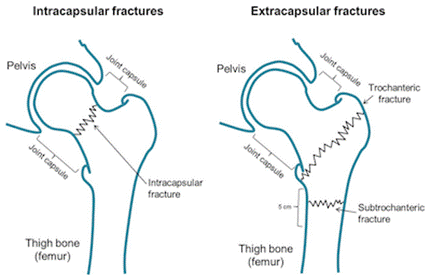
Internal Fixation
Internal fixation is used to preserve your hip joint rather than replace it. Internal fixation means the hip will be fixed or stabilised using metal implants which are a combination of screws, rods and plates attached to the thigh bone.
A dynamic hip screw (DHS) or cannulated screws are used to fix intertrochanteric fractures which occur between the greater and lesser trochanters.
Intramedullary (IM) nailing is used for sub-trochanteric fractures. This is a metal rod, which is inserted down the middle of the femur bone.
Hemiarthroscoplasty
A hemiarthroscoplasty involves removing the ball of the joint and replacing it with an artificial ball and metal stem. The procedure is often the preferred option for intracapsular fractures (inside the socket of the hip joint); as the fracture is unlikely to heal well due to the blood supply being affected.
Total Hip Replacement
A total hip replacement is an operation that involves removing the ball and socket that form the joint and replacing them with an artificial ball, metal stem and socket. This may be considered if you already have a condition that affects your joint, such as arthritis, or if you are very active.
Discomfort
Post-operative pain, swelling and bruising are a normal part of the recovery process following joint replacement surgery. The muscles and tissues surrounding you hip will take time to heal. You will require pain relief medication on a reducing basis, usually over at least 6 weeks following the surgery. Crutch use, ice, activity pacing and rest may help.
Increased discomfort at night and difficulty sleeping is very common following a hip replacement, this should improve with time.
Following your discharge from hospital, you need to apply an ice pack 3 to 4 times daily for 15-20 minutes. You will be able to reduce the frequency of use after this but will find that you will benefit from ice therapy for up to three month to help manage the pain.
If you have any concerns regarding managing your pain, please discuss this with your GP.
Swelling
Swelling and inflammation is a normal part of the healing process. This can last up to a few months or longer but will improve with time. Swelling of the leg is different for everyone and may cause the leg to ache and feel very heavy.
Swelling either around the knee/hip, or throughout the whole leg, is normal. It can worsen once you return home, as you start to do more.
Bruising may appear near the operation site and may then travel throughout the leg (from hip to knee). This is quite normal and may remain for a couple of weeks.
Elevating your leg on a stool or on the bed will also help manage the swelling.
Using an ice compress can help reduce swelling. Wrap and ice pack in a towel, and place over your hip for 15-20 minutes, every 1 to 2 hours.
If your leg suddenly becomes swollen, red, hot, painful or inflamed and you are unable to walk on your operated leg, call your GP as soon as possible. If your GP surgery is closed, go to your nearest A&E Department.
Mobility and Walking Aids
Following a hip fracture most people will require a period of rehabilitation to promote independence with mobility and daily activities.
You will have been assessed by the ward physiotherapist and been discharge home using an appropriate walking aid i.e. walking frame or elbow crutches. If you don’t usually use a walking aid, the physiotherapy team will make an onward referral to progress your mobility and function. This may require arranging to visit you at home.
Your therapist will discuss progression goals in terms of mobility, for example using walking sticks, and agree a rehabilitation programme for you to work towards in regaining your functional ability.
Physiotherapy
Once you have left hospital, you will receive a physiotherapy appointment to either attend at the Queen Elizabeth Hospital, Bensham Hospital or you may require a home visit.
You will be contacted by either telephone or letter to advise when your appointment has been arranged. At this appointment, the physiotherapist will:
- Assess the progress you have made since your discharge from the ward
- Progress your exercise
- Assess your walking and progress to the most appropriate walking aid
- Answer any queries you may have
Follow up appointments will be arranged for physiotherapy at this appointment if the therapist feels it is necessary.
When should I seek help?
You should see your doctor urgently if you:
- Have a sudden increase in severe pain, swelling or tenderness in the calf which is getting worse and not just related to pain expected while performing the exercises
- Have concerning pain, swelling or tenderness in the joint which is getting worse
- Develop a high temperature and feel unwell
- See fluid, pus or blood coming from the wound
- Develop new numbness or tingling near to the joint
Stairs and Steps
Going up stairs with a rail
Keep your crutch(es) on the step you are standing on.
Step up with your un-operated leg, then your operated leg and then bring your crutch(es) up onto the same step.
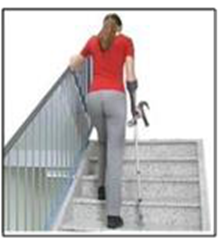
Going down stairs with a rail
Put you crutch(es) down first into the middle of the step below. Step down with your operated leg and then follow by your un-operated leg.
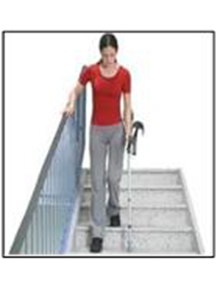
Going up stairs without a rail
Keep your crutches on the step you are standing on.
Step up with your un-operated leg, then your operated leg and then bring your crutches up onto the same step.
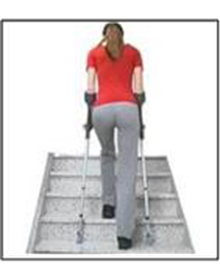
Going down stairs without a rail
Put your crutches down first into the middle of the step below. Step down with your operated leg and then follow with your un-operated leg.

Ankle Exercises
Ankle Bends
Lying or sitting: bring your toes up towards you and then push your toes down away from you.
Repeat 10-15 times, 3 to 4 times a day.

Ankle rotations
Lying or sitting: rotate your ankle in a circular movement (both directions)
Repeat 10-15 times, 3 to 4 times a day.

Hip Exercises (in lying)
Static glutes
Lying on your back:
Squeeze buttocks firmly together
Repeat 10-15 times, 3 to 4 times a day.
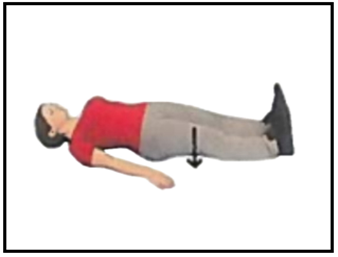
Hip Abduction
Lying on your back:
Slide your leg out to the side. Keep your body straight throughout the exercise
Repeat 10-15 times, 3 to 4 times a day
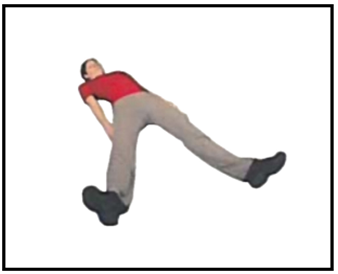
Hip Flexion
Lying on your back:
Bend your knee slowly towards you then straighten maintaining good control throughout the exercise
Repeat 10-15 times, 2 to 4 times a day.

Bridging
Lying on your back:
Both knees bent and feet on the bed. Lift your pelvis and lower back off the bed
Repeat 10-15 times, 3 to 4 times a day.
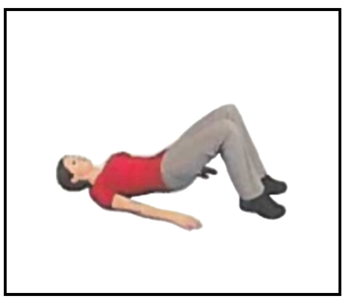
Hip Exercises (in sitting)
Heel raises
Ensure good sitting posture:
Lift your heels up off the floor slowly
Repeat 10-15 times, 3 to 4 times a day.
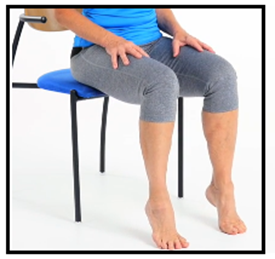
Seated Quads
Ensure good sitting posture:
Straighten your knee, maintaining good control, and lower slowly
Repeat 10-15 times, 3 to 4 times a day.

Arm Press
Ensure good sitting posture:
Place hands on the arms of chair and push up, lifting your bottom off the chair so that your arms are straight
Repeat 10-15 times, 3 to 4 times a day.

Seated Flexion
Ensure good sitting posture:
Keep knee bent and lift one knee up slowly
Repeat 10-15 times, 3 to 4 times a day.

Hip Exercises (in standing)
Abduction
Holding onto a chair or kitchen bench:
Lift your operated leg to the side keeping your foot pointing forwards
Repeat 10-15 times, 3 to 4 times a day.
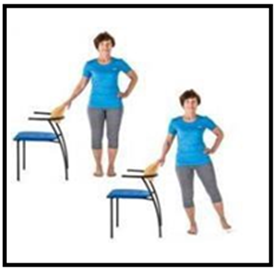
Extension
Holding onto a chair or kitchen bench:
Stretch your leg out behind you keeping your body straight
Repeat 10-15 times, 3 to 4 times a day.
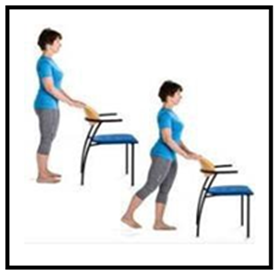
Flexion
Holding onto a chair or kitchen bench:
Standing upright and slowly bend your knee and hip in front of you
Repeat 10-15 times, 3 to 4 times a day.
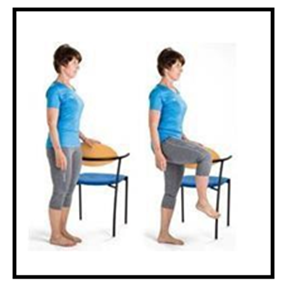
Transport
If you require an ambulance for transport to the group, you will be provide with a telephone number to ring and arrange this. This will be sent out with your physiotherapy appointment letter.
Community Rehabilitation
Occasionally people are discharged home using a walking frame. If appropriate, the ward physiotherapist may need to make a referral to the community team to review and progress rehabilitation at home. You will be contacted by6 either telephone or letter to advise when a visit can be arranged.
Please note: if you have not received notification of your follow up physiotherapy appointment(s) within 2 weeks of leaving hospital, please ring 0191 445 2320 so we can check your referral.
Work
Returning to work will be dependent on the demands of your job. This will be guided by your surgical team and physiotherapist. This will be sooner if you have a sedentary/desk based job. If you have a heavy manual job, you may require longer off work. You can discuss this with you GP or Consultant if you are not sure.
Driving
You will not be able to drive for at least 6 weeks following your operation. Once you are able to walk without any mobility aids, you can drive when you feel safe to do an emergency stop and safely control a car. You must tell your insurance company that you have had hip surgery. If in doubt, contact your Consultant or GP.
Telephone Numbers
If you are at all worried by your hip, please contact us:
| During the hours of 8am – 8pm contact the Orthopaedic secretaries | 0191 445 8500 |
| During the hours of 8pm – 8am contact the Peter Smith Surgery Centre, Queen Elizabeth Hospital | 0191 445 2028 |
| During the hours of 0800 – 16:30 contact the Physiotherapy Department | 0191 445 2320 |
| During the hours of 8am-8pm. If you have a Gateshead or Newcastle GP, the TIMS will be your physiotherapy provider. If you have a query about your first appointment with TIMS please contact our booking team on 0191 445 2643 If you are a current TIMS patient and have a query about your follow- up appointment please contact our local admin team on 0191 213 8800 | Booking Team: 0191 445 2643 Local Admin Team: 0191 213 8800 https://www.tims.nhs.uk/ |
| During the hours of 8.30am-12pm and 1-4pm. If you have a Durham GP, the County Durham Integrated MSK Service will be your physiotherapy provider. | Central booking team: 01388 455 200 |
| Main Switchboard | 0191 482 0000 |